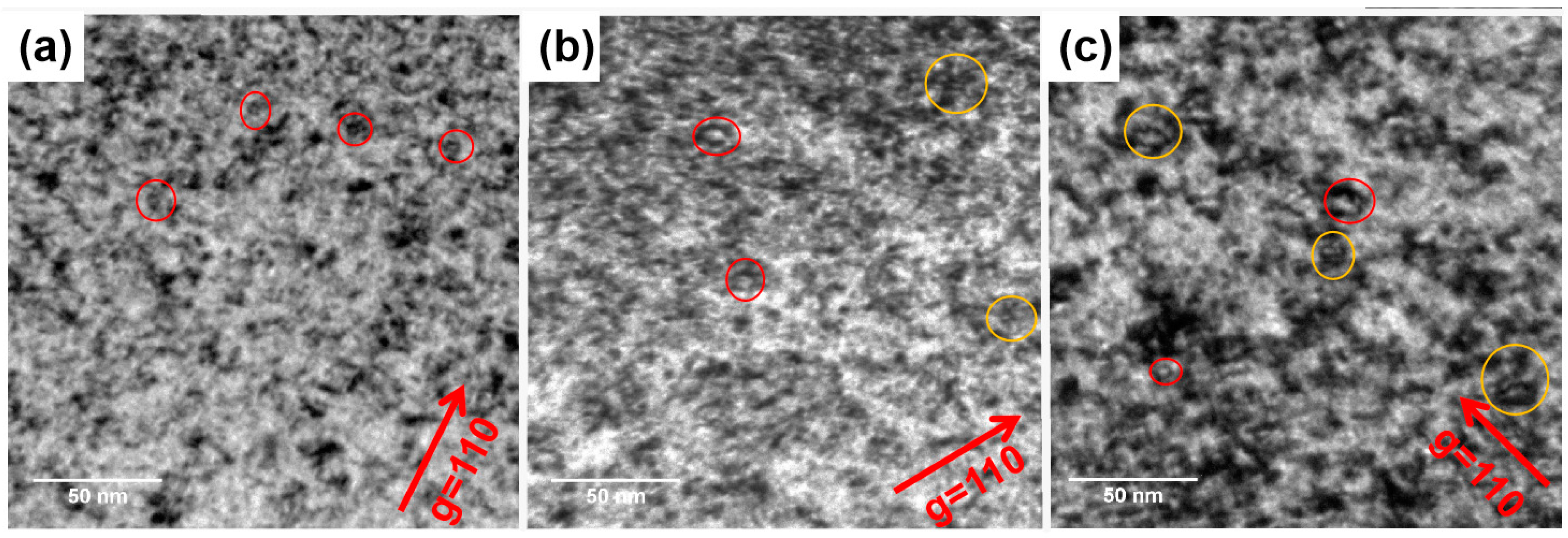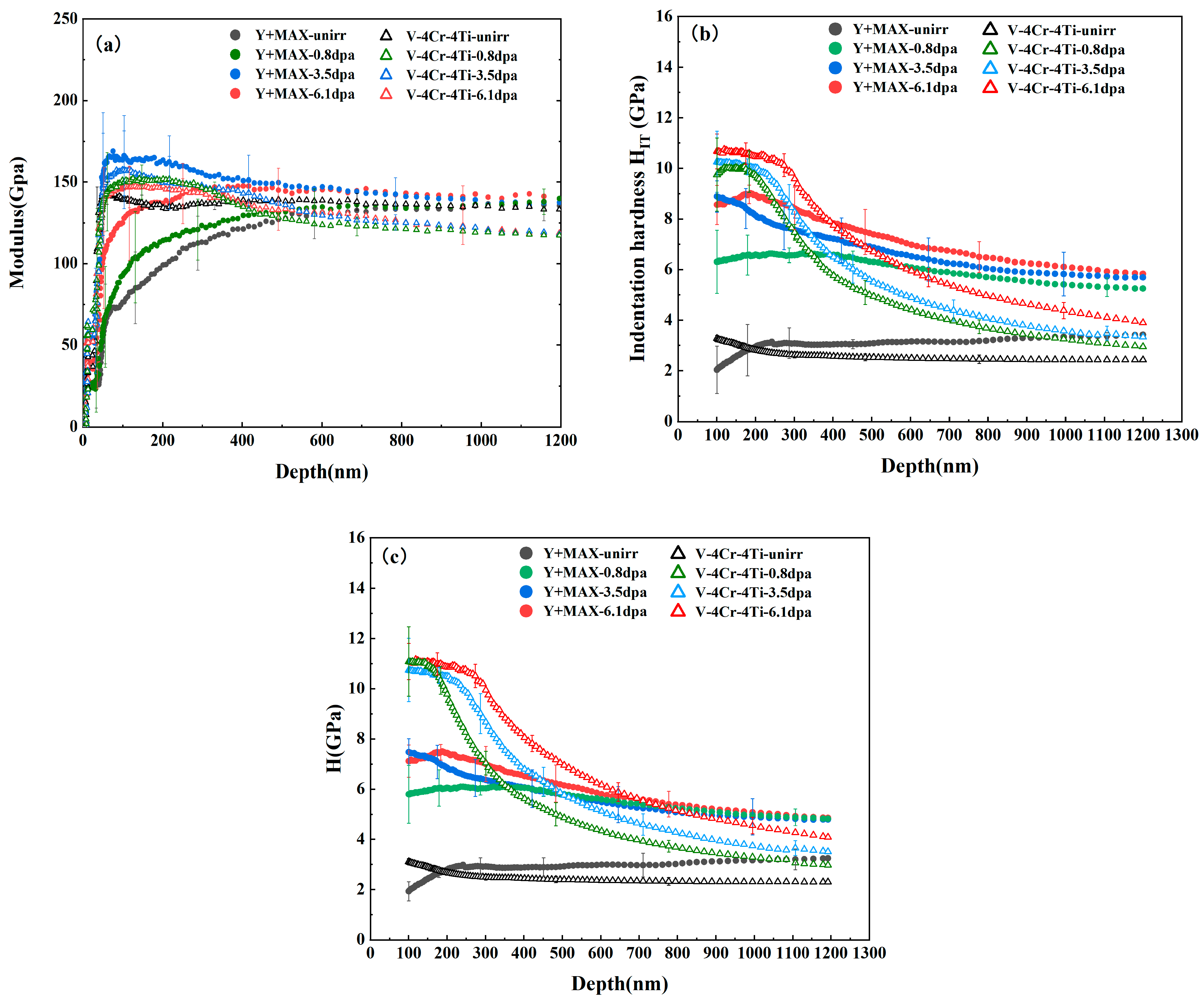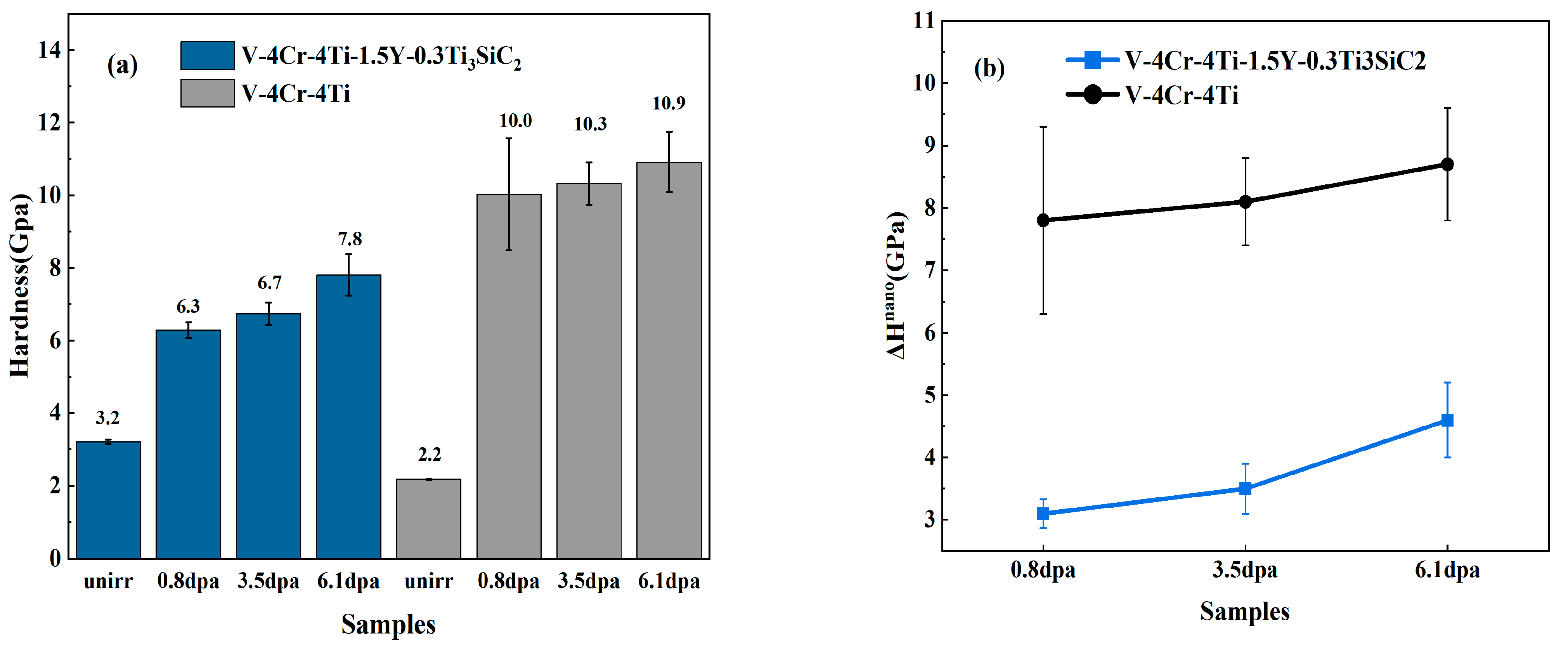Irradiation Hardening and Microstructure Study of MAX-Phase-Dispersion-Strengthened Vanadium Alloy under Self-Ion Irradiation
Abstract
1. Introduction
2. Materials and Methods
2.1. Sample Preparation
2.2. Self-Ion Irradiation
2.3. TEM Observation
2.4. Nanoindentation Test
3. Results
3.1. TEM Observation of Microstructure
3.1.1. Nanoparticles in V-4Cr-4Ti-1.5Y-0.3Ti3SiC2
3.1.2. Irradiation-Induced Defects
3.2. Irradiation Hardening
4. Discussion
4.1. Effect of Irradiation Dose on Nanoparticles
4.2. Effect of Irradiation Dose on Defect Clusters
4.3. Effect of Irradiation Dose on Hardness
5. Conclusions
- (1)
- After irradiation, defect clusters are present in both materials. The growth and merging of defect clusters with irradiation dose are observed in both materials.
- (2)
- Both materials exhibit significant irradiation hardening, and hardness increases as the irradiation dose rises. V-4Cr-4Ti reaches hardening saturation before 0.8 dpa, whereas V-4Cr-4Ti-1.5Y-0.3Ti3SiC2 may not saturate even at 6.1 dpa.
- (3)
- Compared with V-4Cr-4Ti, V-4Cr-4Ti-1.5Y-0.3Ti3SiC2 had a larger initial hardening value and smaller irradiation hardening value. This can be attributed to the fact that the boundary between the nanoparticles and the matrix significantly increases the sink strength, suppressing defect evolution and irradiation hardening.
Author Contributions
Funding
Data Availability Statement
Acknowledgments
Conflicts of Interest
References
- Muroga, T.; Chen, J.M.; Chernov, V.M.; Kurtz, R.J.; Le Flem, M. Present status of vanadium alloys for fusion applications. J. Nucl. Mater. 2014, 455, 263–268. [Google Scholar] [CrossRef]
- Luo, L.-M.; Zhao, Z.-H.; Yao, G.; Wu, Y.-C. Recent progress on preparation routes and performance evaluation of ODS/CDS-W alloys for plasma facing materials in fusion devices. J. Nucl. Mater. 2021, 548, 152857. [Google Scholar] [CrossRef]
- Doñate Buendia, C.; Kürnsteiner, P.; Stern, F.; Wilms, M.B.; Streubel, R.; Kusoglu, I.M.; Tenkamp, J.; Bruder, E.; Pirch, N.; Barcikowski, S.; et al. Microstructure formation and mechanical properties of ODS steels built by Laser Additive Manufacturing of nanoparticle coated iron-chromium powders. Acta Mater. 2020, 206, 116566. [Google Scholar] [CrossRef]
- Shibayama, T.; Yamagata, I.; Kurishita, H.; Kayano, H. Development of oxide dispersion strengthened vanadium alloy and its properties. J. Nucl. Mater 1996, 239, 162–169. [Google Scholar] [CrossRef]
- Yasuda, H.; Mori, H. Effect of fast neutron irradiation on the microstructure in particle dispersed ultra-fine grained VY alloys. J. Nucl. Mater. 2004, 45, 29–33. [Google Scholar]
- Kobayashi, S.; Tsuruoka, Y.; Nakai, K.; Kurishita, H. Effect of neutron irradiation on the microstructure and hardness in particle dispersed ultra-fine grained V–Y alloys. J. Nucl. Mater. 2004, 329, 447–451. [Google Scholar] [CrossRef]
- Nagasaka, T.; Murogaa, T.; Li, M.M. Tensile property of low activation vanadium alloy after liquid lithium exposure. Fusion Eng. Des. 2006, 81, 307–313. [Google Scholar] [CrossRef]
- Li, M.M.; Nagasaka, T. Biaxial thermal creep of two heats of V-4Cr-4Ti at 700 and 800 °C in a liquid lithium environment. J. Nucl. Mater. 2007, 367, 788–793. [Google Scholar] [CrossRef]
- Li, M.M.; Hoelzer, D.T.; Grossbeck, M.L. The Influence of lithium environment on tensile behavior and microstructure of V–4Cr–4Ti. J. Nucl. Mater. 2009, 392, 364–370. [Google Scholar] [CrossRef]
- Furuno, T.; Kurishita, H.; Nagasaka, T.; Nishimura, A.; Muroga, T.; Sakamoto, T.; Kobayashi, S.; Nakai, K.; Matsuo, S.; Arakawa, H. Effects of grain size on high temperature creep of fine grained, solution and dispersion hardened V–1.6Y–8W–0.8TiC. J. Nucl. Mater. 2011, 417, 299–302. [Google Scholar] [CrossRef]
- Sakamoto, T.; Kurishita, H.; Furuno, T.; Nagasaka, T.; Kobayashi, S.; Nakai, K.; Matsuo, S.; Arakawa, H.; Nishimura, A.; Muroga, T. Uniaxial creep behavior of nanostructured.; solution and dispersion hardened V–1.4Y–7W–9Mo–0.7TiC with different grain sizes. Mater. Sci. Eng. A 2011, 528, 7843–7850. [Google Scholar] [CrossRef]
- Tallman, D.J.; Anasori, B.; Barsoum, M.W. A critical review of the oxidation of Ti2AlC,Ti3AlC2 and Cr2AlC in air. Mater. Res. Lett. 2013, 1, 115–125. [Google Scholar] [CrossRef]
- Sun, Z. Progress in research and development on MAX phases: A family of layered ternary compounds. Int. Mater. Rev. 2011, 56, 143–166. [Google Scholar] [CrossRef]
- Huang, Q.; Liu, R.; Lei, G.; Huang, H.; Li, J.; He, S.; Li, D.; Yan, L.; Zhou, J. Irradiation resistance of MAX phases Ti3SiC2 and Ti3AlC2: Characterization and comparison. J. Nucl. Mater. 2015, 465, 640–647. [Google Scholar] [CrossRef]
- Le Flem, M.; Liu, X.; Doriot, S.; Cozzika, T.; Monnet, I. Irradiation damage in Ti3(Si,Al)C2: A TEM investigation. Int. J. Appl. Ceram. Technol. 2010, 7, 766–775. [Google Scholar] [CrossRef]
- Wang, C.; Yang, T.; Kong, S.; Xiao, J.; Xue, J.; Wang, Q.; Hu, C.; Huang, Q.; Wang, Y. Effects of He irradiation on Ti3AlC2: Damage evolution and behavior of He bubbles. J. Nucl. Mater. 2013, 440, 606–611. [Google Scholar] [CrossRef]
- Watanabe, H.; Yamasaki, K.; Higashijima, A.; Taguma, H.; Nagasaka, T.; Muroga, T. Microstructural changes of Y-doped V-4Cr-4Ti alloys after ion and neutron irradiation. Nucl. Mater. Energy 2016, 9, 447–450. [Google Scholar] [CrossRef]
- Zhang, Y.F.; Li, R.R.; Diao, S.Z.; Wan, F.R.; Zhan, Q. Plasticity Improvement and Radiation Hardening Reduction of Y Doped V-4Cr-4Ti Alloy. J. Nucl. Mater. 2022, 560, 153508. [Google Scholar] [CrossRef]
- Luo, H.; Luo, F.; Chen, Y.; Wang, J.; Liu, Q.; Li, F.; Xie, Z.; Lin, W.; Guo, L. Effect of yttrium content on microstructure and irradiation behavior of V-4Cr-4Ti-xY alloys. J. Nucl. Mater. 2022, 559, 153480. [Google Scholar] [CrossRef]
- Zhang, Y.F.; Sun, X.Y.; Ma, B.; Wang, J.; Luo, L.; Wu, Y.C. Investigation of the Y effect on the microstructure response and radiation hardening of PM V-4Cr-4Ti alloys after irradiation with D ions. Metals 2023, 13, 541. [Google Scholar] [CrossRef]
- Watanabe, H.; Muroga, T.; Nagasak, T. Effects of Irradiation Environment on V–4Cr–4Ti Alloys. Plasma Fusion Res. 2017, 12, 2405011. [Google Scholar] [CrossRef]
- Zheng, P.F.; Chen, J.M.; Nagasaka, T.; Muroga, T.; Zhao, J.J.; Xu, Z.Y.; Li, C.H.; Fu, H.Y.; Chen, H.; Duan, X.R. Effects of dispersion particle agents on the hardening of V–4Cr–4Ti alloys. J. Nucl. Mater. 2014, 455, 669–675. [Google Scholar] [CrossRef]
- Zhang, Y.F.; Du, J.K.; Liu, P.P.; Zheng, P.F.; Yang, S.W.; Wan, F.R.; Zhan, Q. Response of microstructure and hardening to deuterium ion irradiation in V-4Cr-4Ti-1.8Y-0.4Ti3SiC2 and V-4Cr-4Ti alloy. Fusion Eng. Des. 2020, 159, 111789. [Google Scholar] [CrossRef]
- Chen, Y.; Guo, L.; Long, Y.; Xie, Z.; Luo, H.; Lin, W.; Huang, Q. Establishment of multi-beam irradiation facility at Wuhan University. Nucl. Inst. Methods Phys. Res. A 2022, 1040, 167202. [Google Scholar] [CrossRef]
- Mansur, L.K. Theory of transitions in dose dependence of radiation effects in structural alloys. J. Nucl. Mater. 1993, 206, 306–323. [Google Scholar] [CrossRef]
- Kartamyshev, A.I.; Lipnitskii, A.G.; Boev, A.O.; Nelasov, I.V.; Maksimenko, V.N.; Aksyonov, D.A.; Nguyen, T.K. Angular dependent interatomic potential for Ti-V system for molecular dynamics simulations. Model. Simul. Mater. Sci. Eng. 2020, 28, 055010. [Google Scholar] [CrossRef]
- Zinkle, S.J.; Snead, L.L. Designing Radiation Resistance in Materials for Fusion Energy. Annu. Rev. Mater. Res. 2014, 44, 241–267. [Google Scholar] [CrossRef]
- Liu, Y.; Kondo, S.; Yu, H.; Yabuuchi, K.; Kasada, R. Evaluation of irradiation hardening in ODS-Cu and non ODS-Cu by nanoindentation hardness test and micro-pillar compression test after self-ion irradiation. Nucl. Mater. Energy 2021, 26, 100903. [Google Scholar] [CrossRef]
- Hasenhuetl, E.; Kasada, R.; Zhang, Z.; Yabuuchi, K.; Huang, Y.-J.; Kimura, A. Evaluation of Ion-Irradiation Hardening of Tungsten Single Crystals by Nanoindentation Technique Considering Material Pile-Up Effect. Mater. Trans. 2017, 58, 749–756. [Google Scholar] [CrossRef]
- Fischer-Cripps, A.C. Critical review of analysis and interpretation of nanoindentation test data. Surf. Coat. Technol. 2006, 200, 4153–4165. [Google Scholar] [CrossRef]
- Miyazawa, T.; Nagasaka, T.; Kasada, R.; Hishinuma, Y.; Muroga, T.; Watanabe, H.; Yamamoto, T.; Nogami, S.; Hatakeyama, M. Evaluation of Irradiation Hardening of Ion-Irradiated V-4Cr-4Ti and V-4Cr-4Ti-0.15Y Alloys by Nanoindentation Techniques. J. Nucl. Mater. 2014, 455, 440–444. [Google Scholar] [CrossRef]
- Yan, H.; Zhan, Z.; Wang, J.; Okonkwo, B.O.; Han, E.-H. Effects of MeV Fe Ions Irradiation on the Microstructure and Property of Nuclear Grade 304 Stainless Steel: Characterized by Positron Annihilation Spectroscopy, Transmission Electron Microscope and Nanoindentation. Acta Metall. Sin. Engl. Lett. 2021, 34, 1695–1703. [Google Scholar] [CrossRef]
- Nix, W.D.; Gao, H. Indentation size effects in crystalline materials: A law for strain gradient plasticity. J. Mech. Phys. Solids 1998, 46, 411–425. [Google Scholar] [CrossRef]
- Muroga, T.; Miyazawa, T.; Nagasaka, T.; Atanabe, H.W. Correlation of Microstructural Evolution in V-4Cr-4Ti by Heavy Ion and Neutron Irradiations. Plasma Fusion Res. 2016, 11, 2405007. [Google Scholar] [CrossRef][Green Version]
- Li, Y.; Wang, L.; Ran, G.; Yuan, Y.; Wu, L.; Liu, X.; Qiu, X.; Sun, Z.; Ding, Y.; Han, Q.; et al. In-situ TEM investigation of 30 keV he+ irradiated tungsten: Effects of temperature, fluence, and sample thickness on dislocation loop evolution. Acta Mater. 2021, 206, 116618. [Google Scholar] [CrossRef]
- Yipeng, L.; Miaosen, Y.; Guang, R.; Ning, G.; Yang, C.; Qing, H.; Hui, W.; Zhehui, Z.; Jinchi, H. In-situ TEM study and molecular dynamics simulation of dislocation loop evolution in FeCrAl alloysunder Fe+ irradiation. Mater. Today Energy 2021, 21, 100788. [Google Scholar]
- Oka, H.; Watanabe, M.; Kinoshita, H.; Shibayama, T.; Hashimoto, N.; Ohnuki, S.; Yamashita, S.; Ohtsuka, S. In situ observation of damage structure in ODS austenitic steel during electron irradiation. J. Nucl. Mater. 2011, 417, 279–282. [Google Scholar] [CrossRef]
- Srinivasan, S.; Kale, C.; Hornbuckle, B.C.; Darling, K.A.; Chancey, M.R.; Hernandez-Rivera, E.; Chen, Y.; Koenig, T.R.; Wang, Y.Q.; Thompson, G.B.; et al. Radiation tolerance and microstructural changes of nanocrystalline Cu-Ta alloy to high dose self-ion irradiation. Acta Mater. 2020, 195, 621–630. [Google Scholar] [CrossRef]
- Xuxiao, H.; Chonghong, Z.; Mengke, N.; Zhaonan, D.; Jinsung, J.; Tieshan, W.; Akihiko, K. A comparison study of change in hardness and microstructures of a Zr-added FeCrAl ODS steel irradiated with heavy ions. Mater. Sci. Eng. A 2022, 841, 143050. [Google Scholar]







| Sample | Material | Irradiation Fluence (ions cm−2) | Peak Damage (dpa) |
|---|---|---|---|
| Y + MAX-unirr | V-4Cr-4Ti-1.5Y-0.3Ti3SiC2 | unirradiated | - |
| Y + MAX-0.8 dpa | V-4Cr-4Ti-1.5Y-0.3Ti3SiC2 | 1 × 1015 | 0.8 |
| Y + MAX-3.5 dpa | V-4Cr-4Ti-1.5Y-0.3Ti3SiC2 | 4 × 1015 | 3.5 |
| Y + MAX-6.1 dpa | V-4Cr-4Ti-1.5Y-0.3Ti3SiC2 | 7 × 1015 | 6.1 |
| V-4Cr-4Ti-unirr | V-4Cr-4Ti | unirradiated | - |
| V-4Cr-4Ti-0.8 dpa | V-4Cr-4Ti | 1 × 1015 | 0.8 |
| V-4Cr-4Ti-3.5 dpa | V-4Cr-4Ti | 4 × 1015 | 3.5 |
| V-4Cr-4Ti-6.1 dpa | V-4Cr-4Ti | 7 × 1015 | 6.1 |
Disclaimer/Publisher’s Note: The statements, opinions and data contained in all publications are solely those of the individual author(s) and contributor(s) and not of MDPI and/or the editor(s). MDPI and/or the editor(s) disclaim responsibility for any injury to people or property resulting from any ideas, methods, instructions or products referred to in the content. |
© 2024 by the authors. Licensee MDPI, Basel, Switzerland. This article is an open access article distributed under the terms and conditions of the Creative Commons Attribution (CC BY) license (https://creativecommons.org/licenses/by/4.0/).
Share and Cite
Zhao, Y.; Zheng, P.; Wei, Y.; Luo, H.; Qian, W.; Zhang, G.; Li, F.; Zhang, M.; Zhang, P. Irradiation Hardening and Microstructure Study of MAX-Phase-Dispersion-Strengthened Vanadium Alloy under Self-Ion Irradiation. Metals 2024, 14, 141. https://doi.org/10.3390/met14020141
Zhao Y, Zheng P, Wei Y, Luo H, Qian W, Zhang G, Li F, Zhang M, Zhang P. Irradiation Hardening and Microstructure Study of MAX-Phase-Dispersion-Strengthened Vanadium Alloy under Self-Ion Irradiation. Metals. 2024; 14(2):141. https://doi.org/10.3390/met14020141
Chicago/Turabian StyleZhao, Yinshu, Pengfei Zheng, Yaxia Wei, Hongtai Luo, Wei Qian, Guihang Zhang, Feng Li, Ming Zhang, and Pengbo Zhang. 2024. "Irradiation Hardening and Microstructure Study of MAX-Phase-Dispersion-Strengthened Vanadium Alloy under Self-Ion Irradiation" Metals 14, no. 2: 141. https://doi.org/10.3390/met14020141
APA StyleZhao, Y., Zheng, P., Wei, Y., Luo, H., Qian, W., Zhang, G., Li, F., Zhang, M., & Zhang, P. (2024). Irradiation Hardening and Microstructure Study of MAX-Phase-Dispersion-Strengthened Vanadium Alloy under Self-Ion Irradiation. Metals, 14(2), 141. https://doi.org/10.3390/met14020141





